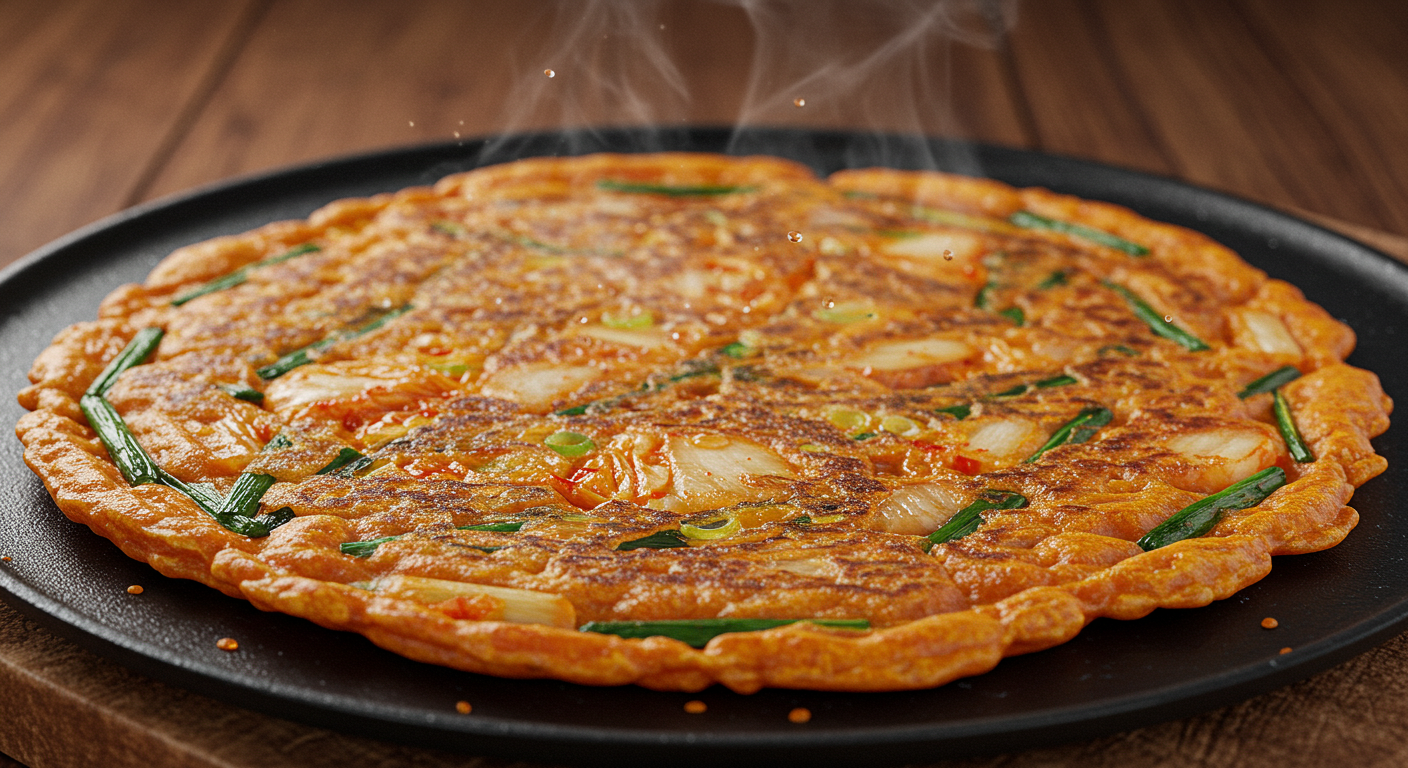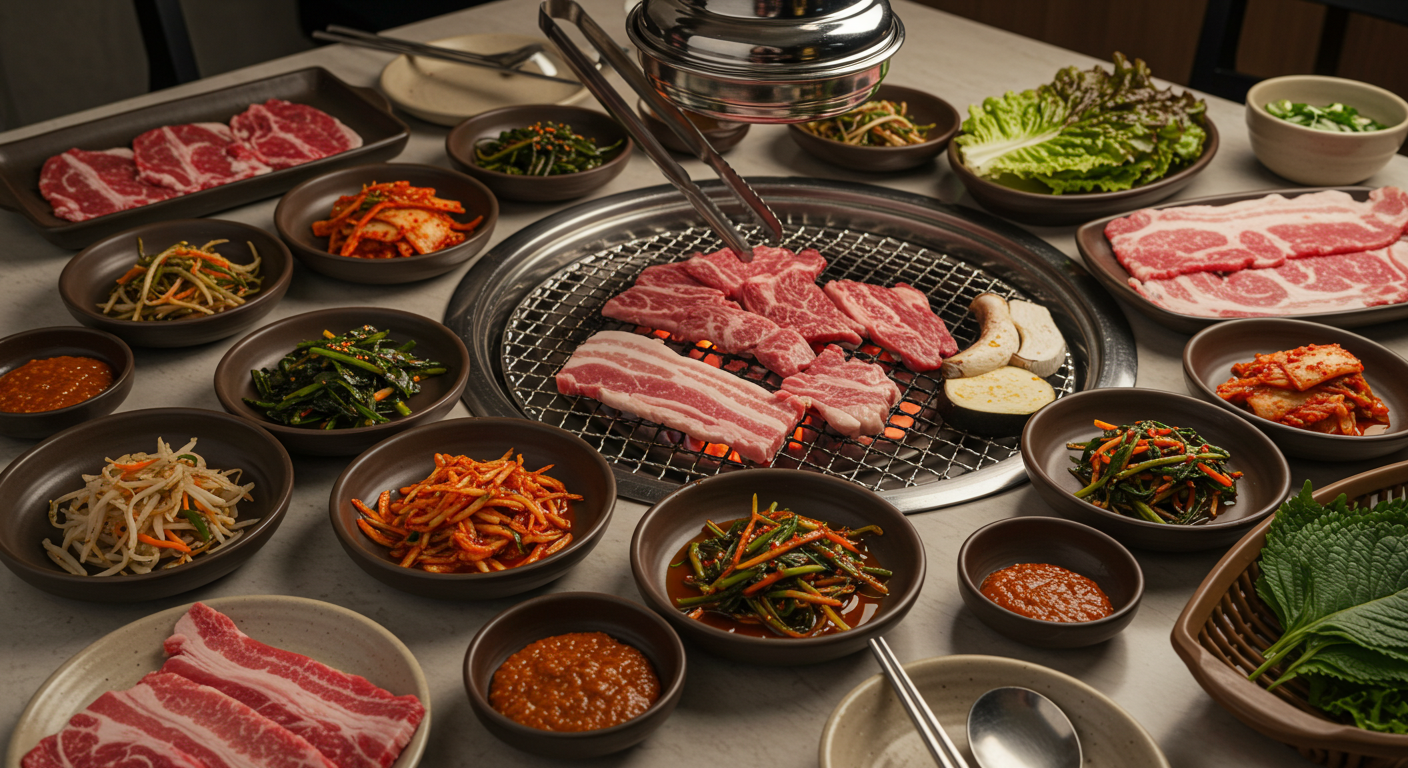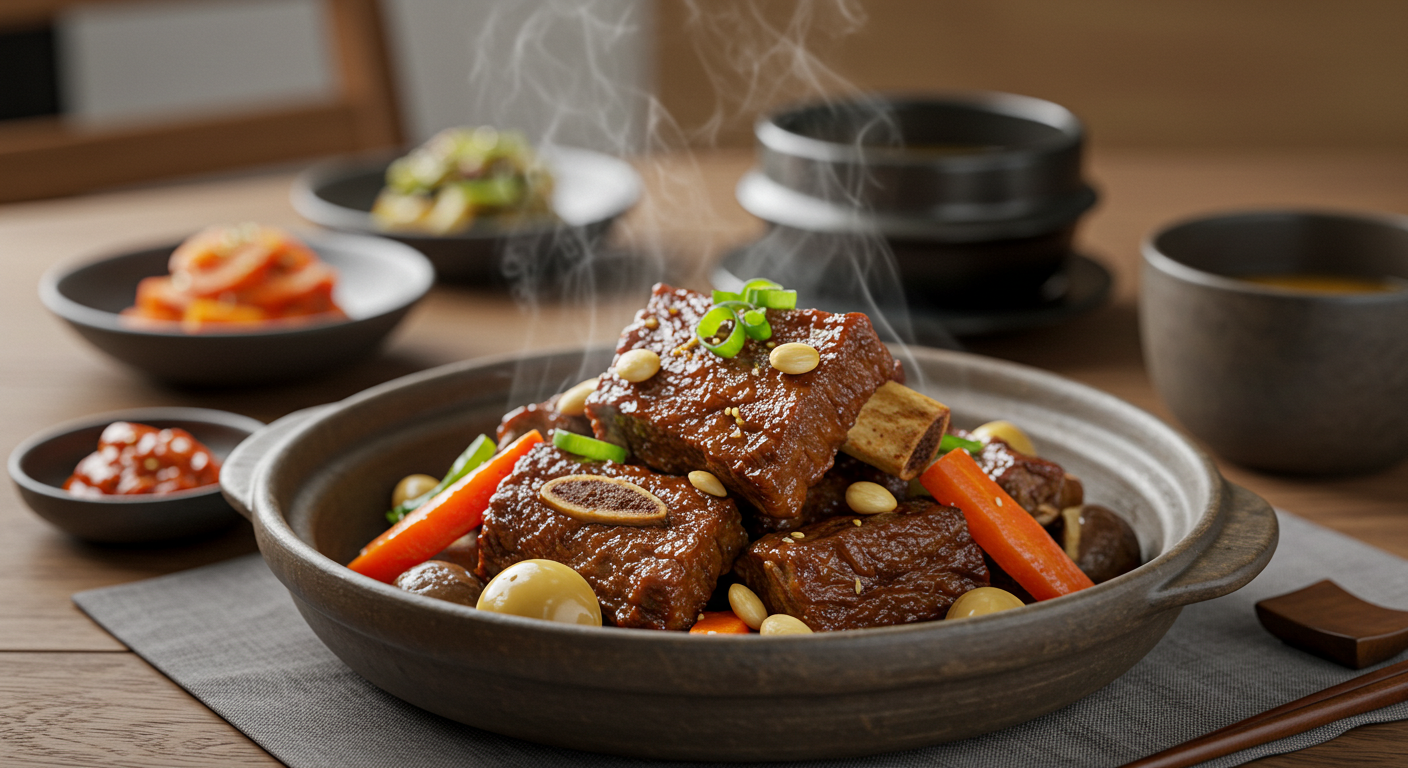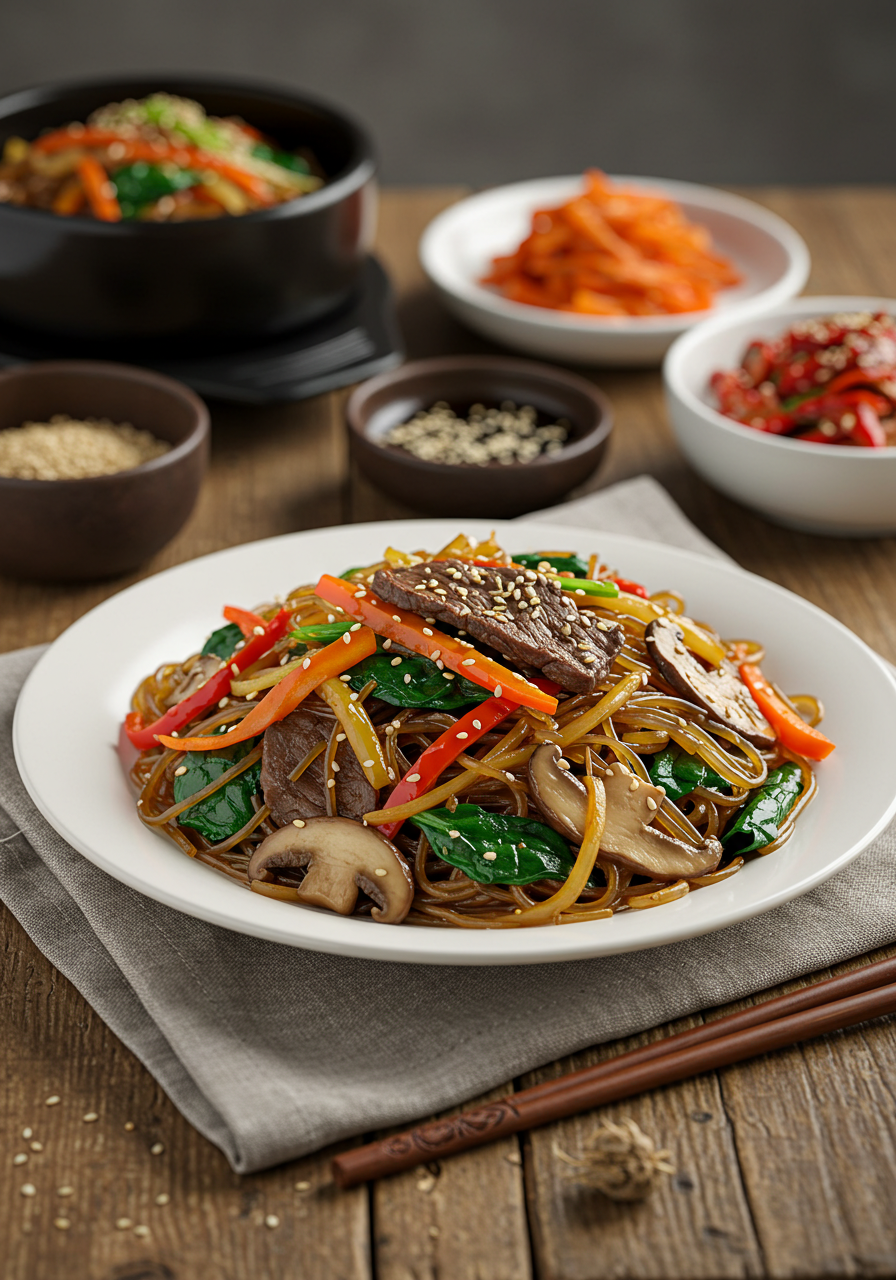
Curious how to make traditional Korean Food Japchae at home? Experience the vibrant colors and rich flavors of Japchae, a delightful Korean noodle dish. This guide will help even beginners create delicious Japchae Recipe without a hitch!
Hello everyone! 😊 As someone who absolutely loves cooking, today I want to introduce you to a very special Korean dish. You might have seen it in K-dramas or movies – it’s Japchae! Honestly, when I first thought about making it, I was like, ‘How on earth do I make this?’ But it turned out to be much easier than I expected. It’s a dish where various vegetables and chewy glass noodles come together, making it a feast for both the eyes and the palate. While it might seem like a special dish only for holidays or banquets, it’s actually great to make at home as a side dish. Today, I’ll share my tips and recipe so you can easily make Japchae too! If you’re new to Korean cooking, check out this beginner-friendly Korean food guide for more basics.
What Exactly is Japchae? 🤔
Japchae is one of Korea’s representative celebratory dishes, made by stir-frying various colorful vegetables (like carrots, spinach, onions, mushrooms) and meat, then tossing them with glass noodles (made from sweet potato starch) in a soy sauce-based seasoning. The word ‘Jap (雜)’ means ‘mixed’ or ‘various,’ and ‘Chae (菜)’ means ‘vegetables.’ As the name suggests, it’s characterized by the harmonious blend of various ingredients. The chewy texture of the noodles and the crispness of the vegetables are truly exquisite!
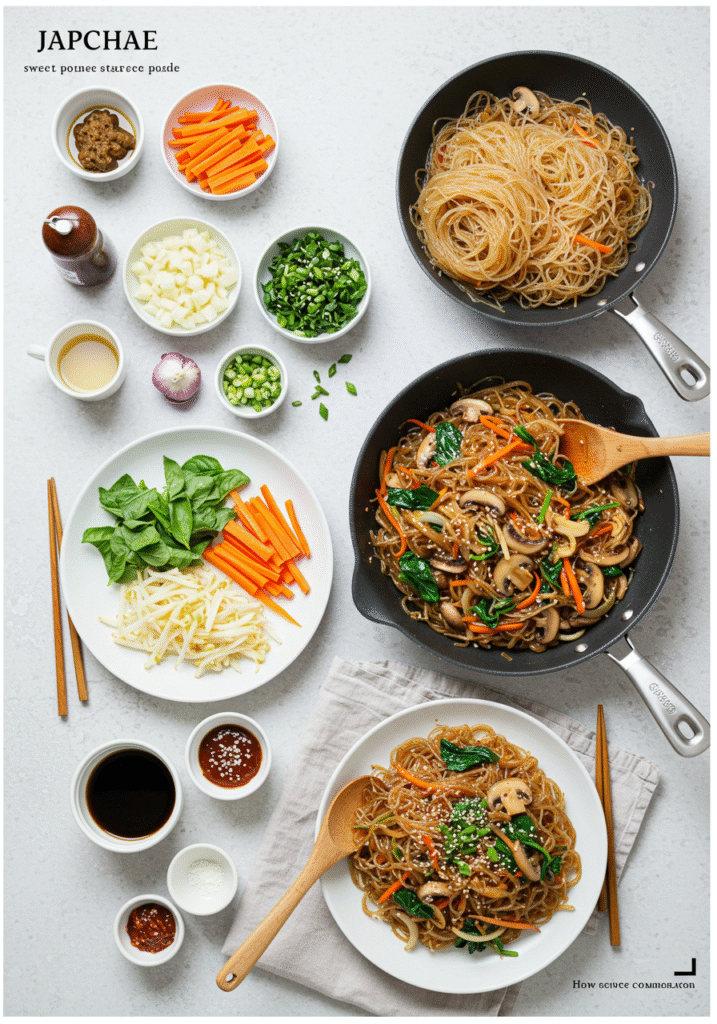
Essential Ingredients for Delicious Japchae 🛒
Japchae might seem complicated because of the many ingredients, but it’s not too bad once you start preparing them one by one. This is how I usually prepare them, feel free to adjust according to your preference!
| Category | Ingredient | Recommended Amount (for 4 servings) |
|---|---|---|
| Essential | Glass Noodles (Dangmyeon) | 300g |
| Vegetables | Spinach, Onion, Carrot, Shiitake Mushrooms (or Wood Ear Mushrooms), Bell Pepper (optional) | 50g~100g each (about a handful) |
| Protein | Beef (bulgogi cut or for stir-fry) or Pork | 150g (optional) |
| Basic Seasonings | Soy Sauce, Sugar, Sesame Oil, Minced Garlic, Black Pepper, Toasted Sesame Seeds | (Details in recipe) |
💡 Good to know!
You can be flexible with Japchae ingredients based on what you have in your fridge. Feel free to use oyster mushrooms or king oyster mushrooms instead of shiitake, and if you don’t have meat, you can omit it or add fish cakes for a different twist!
Let’s Make Japchae! Easy-Peasy Recipe 👩🍳
Alright, shall we start making Japchae? I usually follow these steps. It might look a bit long, but if you follow along step by step, you can totally do it!
- Prepare and Season Ingredients:
- Spinach: Wash thoroughly, blanch in boiling salted water for about 30 seconds, then rinse in cold water and squeeze out excess water. Season with 0.5 tbsp soy sauce, 0.5 tbsp sesame oil, and a pinch of minced garlic.
- Onion, Carrot, Bell Pepper: Slice thinly.
- Mushrooms: Slice into bite-sized pieces.
- Meat (optional): Slice thinly and marinate with 1 tbsp soy sauce, 0.5 tbsp sugar, 0.5 tbsp minced garlic, 0.5 tbsp sesame oil, and a dash of black pepper.
- Stir-fry Each Ingredient Separately:It’s important to stir-fry each ingredient separately to keep their colors vibrant and distinct. Heat some cooking oil in a pan over medium-high heat and quickly stir-fry. (It’s convenient to stir-fry in this order: Meat -> Carrot -> Onion -> Mushrooms -> Bell Pepper)
- Meat: Stir-fry until fully cooked, then set aside.
- Vegetables: Stir-fry just until slightly wilted, keeping their crisp texture. Season lightly with a pinch of salt.
- Boil the Glass Noodles:The most crucial part: the noodles! Boil the glass noodles in plenty of boiling water for 7-8 minutes. Once the noodles become translucent and soft, immediately drain and rinse them in cold water, then drain thoroughly. (It’s important to work quickly so they don’t get soggy!)⚠️ Be careful!
If you boil the glass noodles for too long, they’ll become soggy and break easily, losing their delicious texture. Refer to the package instructions, but it’s better to drain them when they’re slightly undercooked. They’ll continue to cook with residual heat when you mix them with the sauce! - Make the Special Sauce:The key to Japchae’s flavor is the sauce! You can make a perfect sauce with the following ratio.Japchae Sauce (for 300g noodles) 📝
- Soy Sauce: 6 tbsp
- Sugar: 3 tbsp
- Sesame Oil: 3 tbsp
- Minced Garlic: 1.5 tbsp
- Black Pepper: A pinch
- Toasted Sesame Seeds: 2 tbsp
- Combine All Ingredients:In a large mixing bowl, combine the boiled glass noodles and all the stir-fried ingredients (spinach, cooked vegetables, meat). Pour in all the prepared sauce. Put on a pair of disposable gloves and gently mix everything by hand. Be careful not to break the noodles, and ensure the sauce is evenly distributed. Finally, drizzle a little more sesame oil and sprinkle with toasted sesame seeds. Done!
📌 Cooking Tip!
Adding 1 tablespoon of cooking oil to the boiling water when cooking the noodles helps prevent them from sticking together and makes them chewier. Also, lightly coating the boiled noodles with sesame oil before mixing helps them separate better and absorb the sauce evenly.
Enjoy Your Own Japchae! 🍽️
Japchae is best eaten fresh, but don’t worry if you have leftovers! It’s still delicious even after being refrigerated. You can gently reheat it in the microwave or stir-fry it again in a pan to bring back some of its original flavor. I sometimes make Japchae-bap (Japchae with rice) – just put a generous amount of Japchae over rice, sprinkle some seaweed flakes, and mix it all together. It’s absolutely amazing! It’s also a great addition to kimbap. Try enjoying Japchae in your own unique way. For more Korean recipes, visit our FAQ section below!
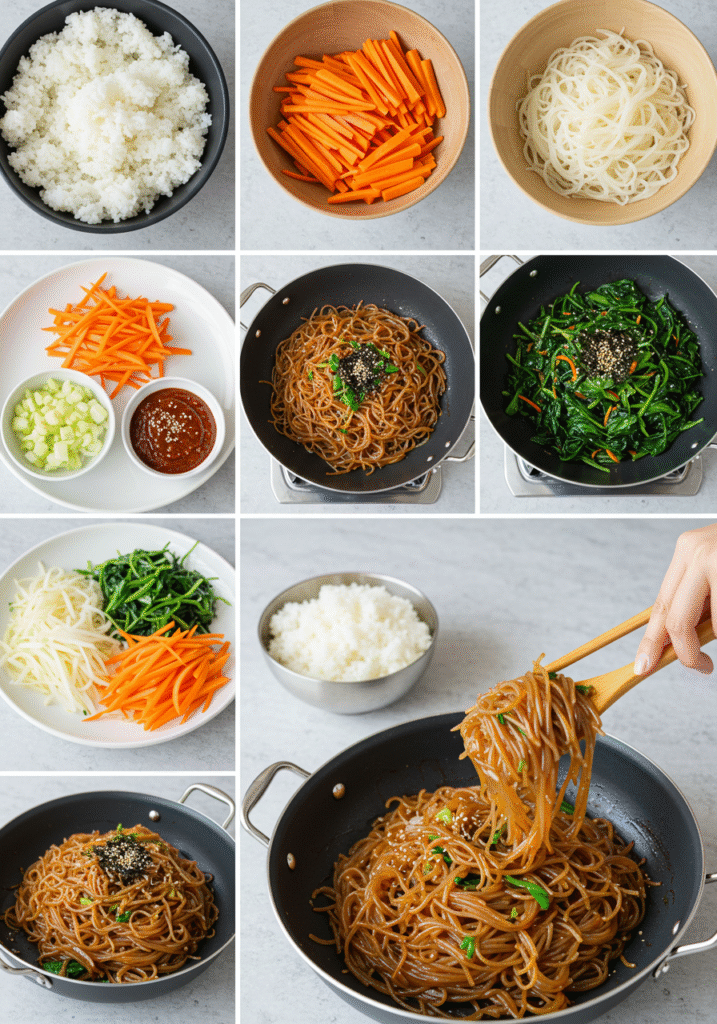
Key Takeaways from This Post 📝
Let’s quickly review the key points for making Japchae that we covered today!
- Ingredient Preparation: Various vegetables, meat, and chewy glass noodles are essential! Feel free to adjust based on your preferences.
- Stir-frying Separately: It’s crucial to stir-fry each ingredient individually to preserve their flavor and color.
- Noodle Cooking: Stick to the package instructions! Be careful not to overcook them, rinse in cold water, and drain well.
- Golden Sauce: Remember the golden ratio of soy sauce, sugar, sesame oil, garlic, pepper, and sesame seeds.
- Mixing with Love: Combine all ingredients and the sauce, then gently mix by hand to ensure everything is well coated!
💡
Secrets to Japchae Success!
Separate Stir-frying: Preserve the texture and color of each ingredient.
Noodle Management: Cooking time is key! Rinse in cold water to prevent sogginess.
Delicious Sauce:
Soy Sauce 6 : Sugar 3 : Sesame Oil 3 : Minced Garlic 1.5
Final Mixing: Gently mix by hand to ensure all ingredients are well coated.
Remember these tips to become a Japchae master! 🚀
Frequently Asked Questions ❓
Q: Which vegetables are essential for Japchae?
A: Spinach, onion, and carrot are commonly used, but you can add bell peppers, various mushrooms (shiitake, oyster, etc.), or even chives according to your preference! Feel free to use what you have in your fridge.
Q: My Japchae noodles get too soggy or clump together, what should I do?
A: 👉 When boiling the noodles, follow the package instructions precisely, and immediately after boiling, rinse them thoroughly in cold water to remove starch and drain well. Adding 1 tablespoon of cooking oil to the boiling water also helps.
Q: Do I have to add meat?
A: No! Japchae is delicious even with just vegetables. Instead of meat, you can increase the amount of mushrooms, or add fish cakes or egg strips for extra protein. Vegan Japchae is also incredibly tasty!
Q: My Japchae noodles become hard after some time. Is there a solution?
A: 👉 Japchae noodles can absorb moisture and become hard over time. Just before serving, you can add a small amount of water or broth and reheat it in the microwave or quickly stir-fry it in a pan to make it soft again. Adding a little more sesame oil will also revive its flavor.
Well, I’ve shared all my tips and recipes for making Japchae, a representative Korean celebratory dish! Wasn’t it easier and more fun than you thought? Homemade Japchae will truly feel more special than any other dish. I hope your dining table will be adorned with colorful and delicious Japchae. If you have any more questions, please feel free to ask in the comments! 😊 Happy cooking!

